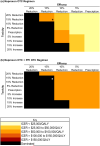Cost-effectiveness of nonsteroidal anti-inflammatory drugs and opioids in the treatment of knee osteoarthritis in older patients with multiple comorbidities
- PMID: 26525846
- PMCID: PMC4761310
- DOI: 10.1016/j.joca.2015.10.006
Cost-effectiveness of nonsteroidal anti-inflammatory drugs and opioids in the treatment of knee osteoarthritis in older patients with multiple comorbidities
Abstract
Objective: To evaluate long-term clinical and economic outcomes of naproxen, ibuprofen, celecoxib or tramadol for OA patients with cardiovascular disease (CVD) and diabetes.
Design: We used the Osteoarthritis Policy Model to examine treatment with these analgesics after standard of care (SOC) - acetaminophen and corticosteroid injections - failed to control pain. NSAID regimens were evaluated with and without proton pump inhibitors (PPIs). We evaluated over-the-counter (OTC) regimens where available. Estimates of treatment efficacy (pain reduction, occurring in ∼57% of patients on all regimens) and toxicity (major cardiac or gastrointestinal toxicity or fractures, risk ranging from 1.09% with celecoxib to 5.62% with tramadol) were derived from published literature. Annual costs came from Red Book Online(®). Outcomes were discounted at 3%/year and included costs, quality-adjusted life expectancy, and incremental cost-effectiveness ratios (ICERs). Key input parameters were varied in sensitivity analyses.
Results: Adding ibuprofen to SOC was cost saving, increasing QALYs by 0.07 while decreasing cost by $800. Incorporating OTC naproxen rather than ibuprofen added 0.01 QALYs and increased costs by $300, resulting in an ICER of $54,800/QALY. Using prescription naproxen with OTC PPIs led to an ICER of $76,700/QALY, while use of prescription naproxen with prescription PPIs resulted in an ICER of $252,300/QALY. Regimens including tramadol or celecoxib cost more but added fewer QALYs and thus were dominated by several of the naproxen-containing regimens.
Conclusions: In patients with multiple comorbidities, naproxen- and ibuprofen-containing regimens are more effective and cost-effective in managing OA pain than opioids, celecoxib or SOC.
Keywords: Cost-effectiveness; NSAIDS; Nonsteroidal anti-inflammatory drugs; Opioids; Osteoarthritis.
Copyright © 2015 Osteoarthritis Research Society International. Published by Elsevier Ltd. All rights reserved.
Figures




References
-
- McAlindon TE, Bannuru RR, Sullivan MC, Arden NK, Berenbaum F, Bierma-Zeinstra SM, et al. OARSI guidelines for the non-surgical management of knee osteoarthritis. Osteoarthritis Cartilage. 2014;22:363–388. - PubMed
-
- Jevsevar DS. Treatment of osteoarthritis of the knee: evidence-based guideline, 2nd edition. J Am Acad Orthop Surg. 2013;21:571–576. - PubMed
-
- Hochberg MC, Altman RD, April KT, Benkhalti M, Guyatt G, McGowan J, et al. American College of Rheumatology 2012 recommendations for the use of nonpharmacologic and pharmacologic therapies in osteoarthritis of the hand, hip, and knee. Arthritis Care Res (Hoboken) 2012;64:465–474. - PubMed
Publication types
MeSH terms
Substances
Grants and funding
LinkOut - more resources
Full Text Sources
Other Literature Sources

